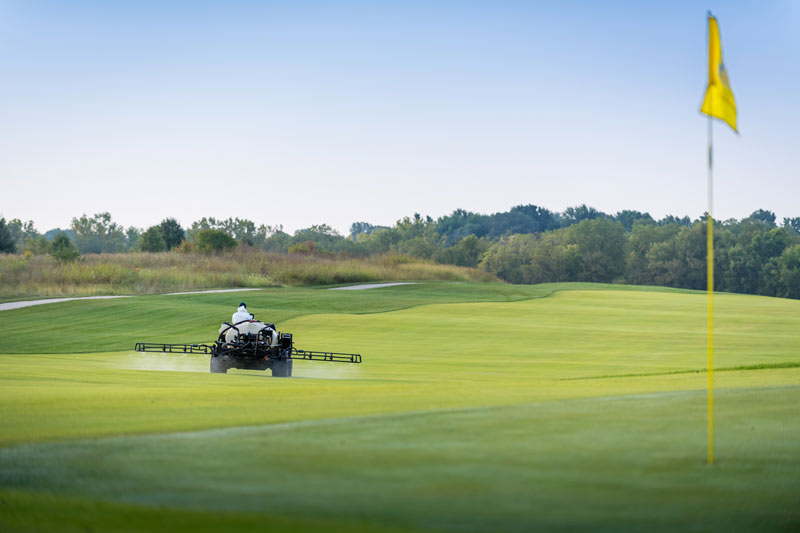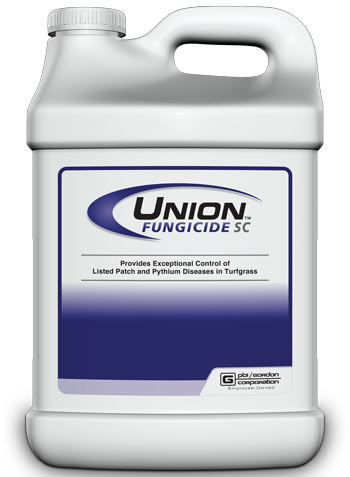
Photos courtesy of PBI-Gordon
Editor’s note: The following article was supplied by PBI-Gordon. All product claims, research cited and other information is directly from the company.
A history of Union and its active ingredients, cyazofamid and azoxystrobin
Union is a premix fungicide of cyazofamid and azoxystrobin that will be available as an SC (suspension concentrate) formulation. Field evaluation began in 2017, and Union received federal registration during fall 2019.
Cyazofamid, formulated and distributed as the product Segway Fungicide SC by PBI-Gordon Corp., was first discovered in 1987 by ISK (Ishihara Sangyo Kaisha Ltd.). It was originally registered in Japan in 2001 and received registration by the U.S. EPA in 2004.
Cyazofamid belongs to the QiI (quinone inside inhibitor) group of fungicides (FRAC group 21), which disrupt the electron transport chain at the inside binding site of complex III of the cytochrome B. Cyazofamid is the only fungicide from the cyanoimidazole group registered for use in the United States on turf and ornamentals.
The second active ingredient in Union fungicide is azoxystrobin, which was the first of the strobilurin fungicides to be registered for turf in the United States, in 1997. Natural fungicidal activity from the mushroom Strobilurus tenacellus was first discovered in the late 1970s and was further developed through the 1980s. Strobilurins, or QoI (quinone outside inhibitor) fungicides (FRAC group 11), are very similar to QiI fungicides in that they disrupt the electron transport chain at complex III of the cytochrome B, but they do so at the outside binding site.
What diseases does Union effectively control?
Union fungicide will be the ultimate premix product for control of the pathogens that incite Pythium diseases. Cyazofamid (Segway Fungicide SC, PBI-Gordon Corp.) has been the premier active ingredient of choice for control of the various Pythium species affecting turfgrass, most notably those that cause Pythium root rot, Pythium blight and Pythium root dysfunction. The addition of azoxystrobin to cyazofamid will offer a second mode of action for control of the various pathogens that cause the Pythium diseases commonly found in the turf industry.

Cyazofamid (Segway) only controls diseases caused by oomycete fungi. Therefore, control of the other pathogens listed on the Union label can be attributed to azoxystrobin. Turfgrass managers can expect excellent control of the following diseases, provided resistant populations of the pathogens causing these diseases are not present: anthracnose, brown patch, fairy ring, large patch, leaf spot (Drechslera and Bipolaris spp.), gray leaf spot and summer patch.
Union fungicide is labeled for use on golf courses, athletic fields, commercial and residential lawns, sod farms, and parks.
Where will Union best fit into fungicide programs?
Union will have a unique fit to turfgrass managers’ spray programs, particularly with regard to what diseases are most prevalent on their respective use sites.
For example, for those who struggle with Pythium root rot, Union will be an excellent preventive application once soil temperatures at the 2-inch depth are in excess of 65 F. These are the same temperatures at which other soil-borne fungi become (or are already) active, such as the pathogens that cause summer patch and fairy ring. Should a follow-up application be made to prevent Pythium root rot in the summer months, pathogens that cause diseases such as brown patch and anthracnose will be controlled.
Among the most problematic diseases on commercial and residential lawns that have cool-season turfgrass are leaf spots, Pythium blight and brown patch. Union provides control of the pathogens that cause these diseases. Likewise, diseases of warm-season turf such as large patch, Pythium blight and leaf spots are also controlled with preventive applications of Union.
Union would be ideal for golf course superintendents who manage ultradwarf bermudagrass greens, on which heavy rains associated with cooler weather can result in Pythium blight and leaf spot concerns. Union is a premix product that controls both the pathogens and the subsequent disease as a single product. An application of Union fungicide will give superintendents the peace of mind of knowing control of both diseases is covered in the event of misdiagnosis.
How do we minimize the risk of developing resistance with Union?
Rotation is very important when using site-specific modes of action. Make sure not to apply more than two consecutive applications of Union and no more than two consecutive applications of any QoI (FRAC group 11) or QiI (FRAC group 21).
For example, Union should not be applied twice and preceded or succeeded with an application of Segway, nor should Union be applied more than once if a strobilurin fungicide is applied in the spray immediately before or after a Union application. Remember to always look at premix products being applied before or after Union to verify whether they contain a strobilurin — just because it is part of a premix product does not mean it does not count as a FRAC group 11 application.
There are already documented cases of resistance to strobilurin fungicides. Pathogens demonstrating resistance are Colletotrichum cereale (anthracnose), Magnaporthe oryzae (gray leaf spot) and Pythium aphanidermatum (pythium blight). If resistant populations exist at the desired spray location, the use of a different mode of action is highly recommended.

What tips do you have to make Union applications as effective as possible?
Adequate coverage with the fungicide is the most important aspect for control of fungal pathogens, just as post-application irrigation is essential for control of soil-borne pathogens. Post-application irrigation for control of pathogens harboring in the soil should be applied immediately following an application of Union fungicide. Depending on the target pathogen, one-eighth inch of irrigation or more is recommended.
Ensure that your spray equipment is properly calibrated to deliver 2 gallons of carrier volume per 1,000 square feet. Flat fan nozzles with a 110-degree angle of spray are typically recommended for fungicide applications, but this depends on the height of the boom.
Learn more about Union Fungicide SC on the PBI-Gordon website.
Brian Aynardi, Ph.D., is the Northeast research scientist for PBI-Gordon and leads the company’s fungicide development efforts.